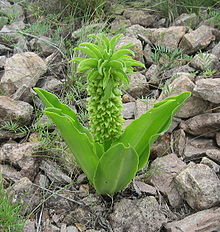Eucomis

Eucomis is a genus of flowering plants in the family Asparagaceae, subfamily Scilloideae, native to southern Africa.[2] Most species of this genus are commonly referred to as pineapple flowers or pineapple lilies. They are bulbous perennials with basal rosettes of leaves and stout stems covered in star-shaped flowers with a tuft of green bracts at the top, superficially resembling a pineapple – hence the common names.[3]
Taxonomy
The genus Eucomis was first published by Charles L’Héritier in 1789.[2][4] The name Eucomis is of Greek origin, eu- meaning “pleasing” and kome “hair of the head”,[5] thus referring to the tuft of leaf-like bracts that crown the inflorescence of the species in this genus. The name was first used by Daniel Solander, who decided that Linnaeus’s Fritillaria regia should be placed in a separate genus. However, Solander died before publishing the name, and was not mentioned by L’Héritier in his 1789 publication.[6] Initially, three species were placed in Eucomis: E. regia, E. nana and E. punctata.[4] (The last two are now synonyms of E. regia and E. comosa respectively.[2])
Classification
Eucomis is placed in the subfamily Scilloideae of the family Asparagaceae by those who use the APG system of plant classification,[7] and in the family Hyacinthaceae by those who use more narrowly defined families.[8] Using the subfamily Scilloideae, Eucomis is placed in the tribe Hyacintheae, subtribe Massoniinae, along with such genera as Lachenalia, Ledebouria, Massonia and Veltheimia.[9]
The species can be divided into two groups. One consists of seven mainly short, diploid species with 2n = 2x = 30 chromosomes: E. amaryllidifolia, E. bicolor, E. grimshawii, E. regia, E. schijffii, E. vandermerwei and E. zambesiaca. The other consists of five mainly larger, tetraploid species with 2n = 4x = 60 chromosomes: E. autumnalis, E. comosa, E. humilis, E. montana and E. pallidiflora.[10]
